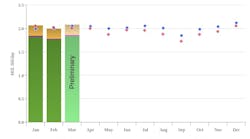The Department of the Interior's US Fish and Wildlife Service (FWS) needs to better manage oil and natural gas activities within its national wildlife refuge system, the General Accounting Office said recently.
GAO's Aug. 28 analysis said FWS should pay more attention to the oil and gas activities under its watch "to increase its understanding of associated environmental effects and contribute to more consistent use of practices and technologies that protect refuge resources."
GAO, the independent auditing arm of Congress, recommended that FWS collect better data, improve training and land acquisition practices, and strengthen permit authority. GAO also called on Interior to ask Congress for additional authority to regulate private mineral rights. While the federal government owns the surface lands in the refuge system, private parties frequently own the subsurface mineral rights. A producer may have legal authority to explore for and extract oil and gas, but regulatory hurdles can be overwhelming—field offices are not consistent about collecting fees, enforcing environmental rules, or issuing permits, GAO found.
Lawmaker concern
Two House lawmakers, Reps. Wayne Gilchrest (R-Md.) and Ed Markey (D-Mass.) asked that GAO inventory past and present oil and gas activity in refuges, identify the environmental effects, and assess FWS's management style.
Gilchrest is the chairman of the subcommittee on Fisheries Conservation, Wildlife, and Oceans on the Committee on Resources; Markey is a senior-ranking member on Resources. Both legislators oppose developing any portion of the Arctic National Wildlife Refuge and generally disapprove of energy development in wilderness areas.
Congress continues to struggle with the ANWR question. But in cases where the White House thinks it has legal authority, regulators are being told to embrace a new land-use policy that may make it easier for producers to drill in refuges and wilderness areas.
The 95 million acre refuge system is made up of federal land designated for conservation and management of fish, wildlife, and plant resources.
About one quarter (155 of 575) of all refuges have past or present oil and gas activity, some dating to the 1920s, according to GAO. Activities range from exploration to drilling and production to pipelines transiting refuge lands. The agency said 105 refuges contain a total of 4,406 oil and gas wells. Today 2,600 wells are dormant. The remaining 1,806 are active but collectively represent only 1% of US production last year. Most active wells are concentrated, not too surprisingly, around the Gulf Coast of Texas and Louisiana.
FWS response
FWS told GAO it is reviewing the report in detail and will "take seriously its recommendations."
The agency agreed with GAO that it could improve guidance to land managers. FWS also pledged to work with mineral rights owners "in an effort to build and maintain partnerships and minimize the adverse impacts of these activities on our fish and wildlife resources." But FWS did not endorse GAO's suggestion to ask Congress for more authority to regulate those mineral rights.
